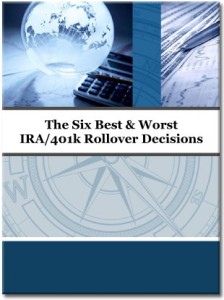 When it’s time to retire, you have a few options on moving the money from your employer’s plan.
When it’s time to retire, you have a few options on moving the money from your employer’s plan.
Direct Rollover: Your employer can directly rollover your retirement plan payout into a Rollover IRA and you will avoid the 20% IRS withholding tax. This is exactly what you should do by providing your employer the name, address and account number of your new Rollover IRA custodian. For example, you give your employer instructions to send your retirement account to ABC securities, account #8889999. Funds are sent directly to the IRA account and you never touch them. This is the preferred method of moving retirement funds.
Payout by Check: If your employer hands you a check for your retirement funds, the employer must withhold 20% for potential taxes. You can avoid the 20% IRS withholding tax on a payout by check from your employer if you deposit the check plus 20% into a rollover IRA within 60 days. In order to complete the tax free rollover, you now have 80% of your IRA rollover in your hand and you must take the other 20% out of your pocket so that you have a completely tax free rollover (you will get the 20% income tax withheld as a refund after you file your tax return). Don’t allow your employer to give you a check, as this requires you to take money out of your pocket to complete your rollover.
Taking a lump sum distribution: This is typically not a wise option because you will pay income tax on the distribution and a 10% penalty if you are under age 59 ½. However, there may be reasons to take a taxable distribution. If you are set on buying a $300,000 boat and spending the rest of your life floating about the globe, then you may need to take your retirement funds now and pay tax. However, if you can avoid using these funds currently, you’ll hopefully have a nest egg when you’re old.


